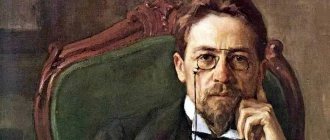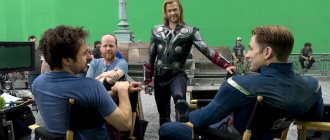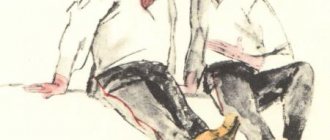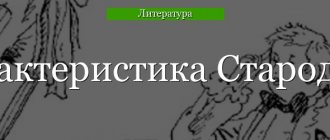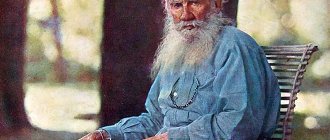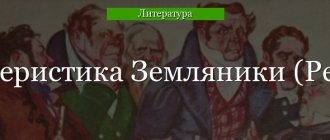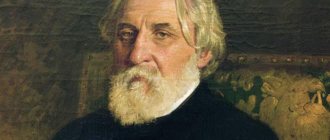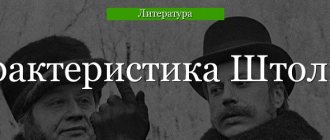Name of the hero of the work (character)
A question that may seem unexpected: what is the name of the hero?
Don’t be surprised, but rather answer: do you know what Pechorin’s name was? And Chichikova? And Bazarova? And Khlestakov? If you were unable to answer some of these questions, please note: we are talking about the main characters! Therefore, this point is not as meaningless as it seems at first glance. Moreover, in some cases the name is not random; there may be significant contexts associated with it that should be remembered. For example, the story about the childhood of “Pavlushi Chichikov” in the poem “Dead Souls”. Or remember how significant the name “Eugene” was for Pushkin: in the introduction to the poem “The Bronze Horseman” he writes that he deliberately returned to the name he had once chosen. Perhaps it was not by chance that this name was chosen by Turgenev for the main character of the novel “Fathers and Sons” - in some way a “hero of the time” (here associations immediately arise with the image of Eugene Onegin as a hero of his time, with the type of “superfluous man”). Sometimes such semantic contexts are associated with more or less episodic characters! For example, who is Zaretsky (not to be confused with Zagoretsky! What explains the similarity of their names?)? (Remember which works contain special discussions and comments (on behalf of the author or the characters themselves) regarding names and nicknames.)
In addition, there is another problem with names: some applicants manage to write them incorrectly. Are you sure that you correctly remember the spelling of such names as Chatsky, Pechorin, Princess Mary, Bela, Skvoznik-Dmukhanovsky (by the way, whose last name is this?), Simeonov-Pishchik (who is this?)?
Common features of Pushkin and Onegin
It is interesting that when creating the hero of a literary work, Pushkin takes facts from his biography. The author, like the character, is tired of the bustle of secular society; he does not see any meaning or impetus for development in it. The classic is engaged in education, studying the history and literature of the country. Crazy love for Russia does not give him the right to become a pessimist, give up and expect that everything will change by itself. The poet writes gloomy epigrams, creates texts that help his contemporaries understand complex problems, and calls for an active position. Onegin has good mental abilities; his “sharp, chilled mind” does not give the hero peace. He gets tired of empty social pastimes and leaves for the village. Onegin studies economic works and tries to change something in the estate he inherited.
There are similar facts in the childhood of the fictional character and the author of the novel. Fathers live in debt, French tutors teach their boys. Youth passes in St. Petersburg, the city of all cultural innovations.
The character of the hero of the work. Individual and typical traits of heroes.
1) Can the hero be attributed to any category of heroes known in literature?
For example,
- “reasoning hero” in a classic work
- "extra person"
- “new people” (in the 1860s - common democrats), etc.
2) Is it possible to associate it with some social phenomenon of more general significance, with a socio-psychological type?
For example,
- Khlestakov and “Khlestakovism”
- Oblomov and “Oblomovism”)? and etc.
If yes, then explain what the essence of this phenomenon or type is.
Traits of character differences
The author was unable to make the hero completely his own copy. Onegin is not keen on literature. He doesn't understand iambs and trochees. He is not interested in writing poems. All the hero is capable of are letters and notes from a traveler. For Pushkin, poetry is a high passion. The attitude towards nature is different, the author draws images from it, receives epithets and new sensations. In nature, the poet relaxes, is distracted, receives peace and satisfaction. Evgeniy is indifferent to the beauty of forests and fields. Men have different attitudes towards the theater. For Onegin, this is a meeting place with unfamiliar beauties, an opportunity to make an impression, to become a conqueror of new women's hearts. For Pushkin, theater is a magical land of feelings and emotions.
The hero's place in the character system
What place does this hero occupy in the system of characters in the work?
- main
- one of the main characters
- secondary
- episodic
- “double” of the main character, etc.
2) What part does this hero take in the conflict of the work:
plot moves in which he participates;
what problems are associated with it (moral, philosophical, etc.);
who he encounters, who argues with him, how the confrontation ends.
The concept of “closeness” of the hero, or My favorite character
Sometimes the hero of a work or movie becomes so close and loved that we try to imitate him, to be like him. This happens for a reason, and it’s not for nothing that the choice falls on this character. Often a favorite hero becomes an image that somehow resembles ourselves. Perhaps the similarity is in character, or in the experiences of both the hero and you. Or this character is in a situation similar to yours, and you understand and sympathize with him. In any case, it's not bad. The main thing is that you imitate only worthy heroes. And there are plenty of them in the literature. We wish you to meet only good heroes and imitate only the positive traits of their character.
Features of the hero's image (techniques and means)
What techniques and means does the writer use when depicting this character:
Portrait of a hero or lack of a portrait
1) Portrait (for example, Lermontov in the novel “A Hero of Our Time” creates a psychological portrait of Pechorin).
2) There may be a significant absence of a portrait. For example, officials in the poem “Dead Souls” are as impersonal as possible. Tatyana Larina, unlike Olga, does not have a portrait in the novel Eugene Onegin. This is explained by the fact that Pushkin shifts attention to the inner world of the heroine (the same can be said about Onegin, in comparison with Lensky; the latter fits well within the framework of a certain type, which is easily recognized by the portrait; Onegin’s character deserves a more in-depth analysis).
Compositional means:
- for example, the main character in a hostile environment is a typical composition of a romantic work;
- comparison with other heroes (which of the characters have “double heroes”?);
- opposition to other heroes, i.e. antithesis: Pechorin and Grushnitsky, Bazarov and Sitnikov, Onegin and Lensky, Chatsky and Molchalin. Note that antithesis can manifest itself in certain aspects of the image, for example in a portrait: compare the above observation about the heroes of the novel “Eugene Onegin”: here we can quite speak of antithesis in the portrait (Onegin - Lensky; Tatyana - Olga).
Speech characteristics of the hero (internal monologues, letters, disputes between heroes, individualization of speech, author’s characterization of the hero)
Speech characteristics
- one of the most important means of characterizing a hero: what does he “tell” about himself? In some cases, the hero communicates something about himself in the literal sense: for example, the self-characterization of the hero in a classic drama (elements of this technique are used by Griboedov). In some cases, the hero’s thoughts about himself become the reader’s main source of information about his inner world: for example, introspection, reflection by Pechorin, Raskolnikov. But in other cases, regardless of the degree of “talkativeness” of the hero in the work, always pay attention to the forms in which his speech is presented:
- monologues;
- internal monologues, reflections
(these techniques play an exceptional role in Tolstoy and Dostoevsky when creating images of reflective heroes); - written language (letter, diary).
Characteristic of works where the author sets the task of psychological analysis (“Hero of Our Time”). Here, too, a vast space opens up for various kinds of reasoning and comparisons: for example, the compositionally symmetrical letters of Onegin and Tatiana: how they are similar, how they differ, what can be said about the mental state of their authors, etc. On the other hand, another useful for essays the idea that can be extracted from these letters - Pushkin translates them, says that Tatiana’s letter lies in front of him - this gives the text more documentary, authenticity (what other techniques does the poet use for the same purpose?). Note that in Tolstoy the same technique is taken to the extreme: in his text the letters are conveyed not only in prose (that is, by definition, more realistically than in a “novel in verse”), but also in the original, in French, as a result of which (in combination with other techniques aimed at creating the effect of “lifeliness”), the illusion of truthfulness and documentary nature of the novel appears. Raskolnikov writes an article that is not given in the text, but is retold, has a certain resonance, and other heroes talk about it. This article undoubtedly characterizes Raskolnikov and his state of mind; - dialogues.
The hero is in dialogue with other characters, in arguments with them. (This, for example, is one of the most important means of revealing characters in the novel “Fathers and Sons”); - individualization of speech:
the very presence of this fact indicates that a realistic method is available to this writer. Earlier literary movements did not yet require realistic depiction of individualized speech, the speech of different social groups, etc. Remember, for example, “Poor Liza,” where all the heroes, representatives of different classes, speak the language of Karamzin himself. Compare this work with the comedy “Woe from Wit” and it will become clear why they talk about Griboyedov’s transition to realism at a time when classicism still dominated the stage. When analyzing the individualized linguistic image of the hero, pay attention to what vocabulary he chooses (colloquial words, archaisms, “learned” vocabulary, various foreign words in the hero’s speech, etc.), what intonation he has: colloquial, pompous, oratorical; complex or primitive construction of a phrase, correct literary speech, or he is illiterate, tongue-tied. Just as in the case of a portrait, the absence of speech can be significant. Remember the comic effect of Prince Tugoukhovsky’s remarks: “A-hm?”, “E-hm?”, “I-hm?”, “U-hm?” - against the backdrop of general verbosity. Remember also the character of the comedy “The Inspector General”, Dr. Gibner, who does not utter a word on stage due to his complete ignorance of the Russian language. - Author's description of the hero.
May be represented to a greater or lesser extent depending on the literary type and genre.
For example, in the lyrics
there may be no other characters at all except the lyrical hero himself, and then there is no point in taking this point into account.
In epic genres
This technique is used to the greatest extent, but here it is necessary to take into account the individual graphic style of the given author. For example, I. S. Turgenev says that a writer should be “a psychologist, but a secret one.” Therefore, in his novels there will not be such extensive comments and explanations as, for example, in L.N. Tolstoy, who is highly didactic. In Turgenev, the reader receives more information about the heroes from plot collisions, monologues and dialogues, portraits, etc. Based on this information, he himself must draw a conclusion about what is happening to the hero. The author almost does not participate in this process, only occasionally giving his own characteristics to the characters (“Yes, he was a dead man” - about Pavel Petrovich).
In a dramatic work
the author is quite constrained in expressing his characteristics and conveying his mood. However, he still has the opportunity to introduce eloquent remarks, in which he makes up for what cannot be conveyed in the hero’s speech. For example, in Chekhov’s play “The Cherry Orchard”:
F and r s (angrily). Leonid Andreich!
F and r s (reproachfully). Leonid Andreich...
Anya (a calm mood has returned to her, she is happy). How good you are, uncle...
- Characterization from other characters
. Sometimes this technique takes on special significance. For example, in the comedy “Woe from Wit,” where the motive of gossip and slander is one of the main elements of intrigue, and the characters exchange malicious cross-characteristics throughout the entire action. Think about the role this technique plays in the poem “Dead Souls.”
The actions and actions of the hero as his characteristics.
The actions and actions of the hero that characterize him. Of course, this technique makes sense mainly in epic and dramatic works. Special cases: the absence or impossibility of committing an act (for example, in the plays of A.P. Chekhov, nothing fundamentally happens, the heroes suffer from the emptiness and meaninglessness of life, from their own passivity - this, according to the author, is a certain sign of the times). In the novel “A Hero of Our Time,” the problem of action arises in different contexts: first of all, it is the discrepancy between outwardly unseemly, reprehensible actions in the eyes of society and their complex motives, known only to the hero himself. In addition, in the novel one can observe unexpected consequences of actions, analyze various reasons leading to this or that action of the hero (up to the influence of fate, predestination), etc. Note that in this novel the means of depicting heroes associated with actions generally acquire great significance due to its action-packed nature.
PORTRAIT OF A LITERARY HERO - COLLECTION OF ESSAYS 7th grade - Essay on Russian literature -
7th grade
Essays on a free topic
PORTRAIT OF A LITERARY HERO
1 option
I really love M. Yu. Lermontov’s poem “Mtsyri”. Mtsyri is my favorite literary character. He loved freedom very much and strove for it.
He was brought to the monastery when he was very young:
He seemed to be about six years old;
Like a chamois of the mountains, timid and wild
And weak and flexible, like a reed.
Mtsyri, accustomed to freedom, gradually gets used to his captivity. He ". I already wanted to make a monastic vow in the prime of my life,” but suddenly on an autumn night the young man disappeared. He could not live in peace - he was sad for his homeland. Even the force of habit could not supplant the longing “for my native side.” Mtsyri decided to flee from the monastery. The dark forest blocks his path to his native place. Escape is a step into an unknown world. What awaits Mtsyri there?
This is a “wonderful world of anxiety and battles,” which the hero dreamed of since childhood, into which he escaped “from stuffy cells and prayers.” Mtsyri, who ended up in the monastery against his own will, strives to go there “where people are free as eagles.”
In the morning he saw what he was striving for: “. Lush fields. Hills covered with a crown of trees,” rustling like “brothers dancing in a circle.”
God's garden was blooming all around me;
Plants rainbow outfit
Kept traces of heavenly tears,
And the curls of the vines
They curled around, showing off between the trees.
Mtsyri subtly feels, understands and loves nature. He rests after the darkness of the monastery and enjoys nature.
The young man set off on the journey: “I had one goal in my soul - to go to my native country,” but suddenly “I lost sight of the mountains and then began to lose my way.” Mtsyri was in terrible despair - the forest, the beauty of the trees and the singing of the birds of which he enjoyed, became “more terrible and denser every hour.” The young man found himself in an element hostile to him: “the darkness watched the night with a million black eyes. »
I admire the heroic character of Mtsyri. During a fight with a leopard in a moment of danger, the young man felt in himself the skills of a fighter that his ancestors had had for centuries. Mtsyri won and, despite his wounds, continued on his way. But in the morning he realized that he was lost and came again to his “prison.” The natural world did not save a person who was forcibly separated from it for many years.
Mtsyri’s dream was not destined to come true, the wounds from the battle with the leopard were fatal, but he did not regret what happened.
The days spent outside the monastery, he lived a real, free life - the one to which he aspired. Mtsyri is a “prison flower”, “the prison left its mark” on him, and therefore he did not find the path to freedom. Nature, with which the hero sought to merge, is not only a beautiful world, but also a formidable force: it is very difficult to cope with it.
Mtsyri dies. Before his death, he asks to be moved to the garden, because in the last minutes of his life there is nothing closer to nature for him, from there he will be able to see the Caucasus, dear to his heart. Mtsyri strove to understand the world, to merge with nature, to feel as free as nature itself, as its free people.
Option 2
My favorite literary character is the Little Prince from the fairy tale of the same name by the French writer Antoine de Saint-Exupéry.
“Some kind of extraordinary kid” with tousled hair, touching and lonely - this is how the main character of the work looks. He lives alone on a tiny planet that is “as big as a house,” and in the morning he cleans it up by weeding out the seeds of the baobab trees.
The author practically does not give us a description of the appearance of his hero. After all, the prince is still a child, and looks like all other children. His appearance cannot yet say anything about him as a person. But the actions of the Little Prince, his remarks give us the opportunity to get to know him. The little prince is very inquisitive, like all children. Questions are pouring out of him; he is interested in everything. He is capable of pure and devoted friendship.
One day, a grain came to his planet, from which a beautiful rose grew. The baby diligently looks after her, but the rose is constantly capricious. He leaves her and goes on a journey. The boy travels from planet to planet, meets a king who has no one to rule, a drunkard who drank to forget that he was ashamed of drinking, a scientist who cannot see life because of books.
And in the end the prince realized that there was nothing better than his planet and his rose. The little one is told the secret that “only the heart is vigilant. You can’t see the most important things with your eyes.” The little prince knows how to love and feel tenderness for another creature. He understands that he is “forever responsible for everyone he has tamed.” The boy realized that the most important thing is to give someone a piece of his heart. This is the secret of human happiness.
The Little Prince charms with his spontaneity, simplicity, kindness, naivety and intelligence.
He is constant in his affections, his heart is pure and open. His moral qualities make us mentally return to this amazing image again and again.
Conclusion
Analyzing these (and others that may have remained unnamed) techniques and means, try to generalize your observations: the meaning of any scientific work, even the smallest one (such as an essay), is precisely to collect various facts and generalize them , reach a more abstract level. A generalization may concern, for example, the literary method that the writer follows: what techniques will be predominantly realistic or classicist, or whether the hero is rather depicted as a character in a romantic work, etc. There may be complex options here: for example, Pechorin is shown to a large extent as a person of a romantic worldview, but the novel clearly contains elements of the realistic method and polemics with romanticism. Another version of the generalization, which takes us beyond the boundaries of a given work, and sometimes beyond the boundaries of the work of a given writer, into a general literary context: is there a previous literary tradition of depicting similar characters; Perhaps other writers have used similar techniques. Did these techniques play the same role for them, or can you point out the differences? If such parallels exist, this would be good material for a final summary. At the end, one can also point to a tradition that, on the contrary, begins with this hero and will be continued by other writers.
